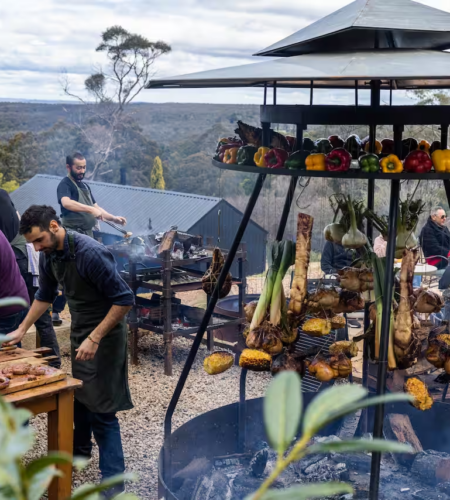While grilling remains a popular outdoor cooking method, numerous other techniques showcase the versatility of cooking over an open flame. Outdoor cooking is a tradition that spans millennia, offering a range of flavors and experiences beyond the familiar barbecue. Here, we explore three unique outdoor cooking methods that bring diverse and delicious flavors to your backyard or campsite.
The Versatility of the Brasero: South American Asado and Beyond
Asado is a cherished culinary tradition in Argentina, Uruguay, Chile, and Paraguay, referring to both the method and the dish itself. This style of cooking involves using a charcoal parrilla grill or an open wood fire, which imparts a distinct smoky flavor and tender texture to the food. At the heart of the asado technique is the iron dome, where vegetables, joints of beef, and whole chickens hang above the flames, slow-roasting for several hours to achieve an exceptionally tender and flavorful result.
Complementing the dome are the plancha and infiernillo. The plancha serves as a versatile grilling surface, while the infiernillo, or “little hell,” is an outdoor oven that creates intense heat between two shelved fire pits. This setup allows for a range of dishes, from chorizo and octopus to whole ocean trout encrusted in salt.
This multi-functional approach allows cooks to prepare a diverse array of foods, from whole chickens to halved peaches. The brasero’s ability to handle different cooking styles—grilling, smoking, and searing—makes it a valuable tool for outdoor cooking enthusiasts. The result is a rich variety of flavors, each imparted with the unique character of the brasero’s fire.
Robatayaki: The Japanese Art of Charcoal Grilling

Originating in Japan, robatayaki, often shortened to “robata,” is a traditional grilling technique that highlights the freshness and natural flavors of seafood and other ingredients. The name “robatayaki” wasn’t coined until the 1950s when the Robata restaurant in Sendai popularized this method. Before then, grilling seafood over hot charcoal was a common, albeit unbranded, tradition.
Robatayaki involves grilling fresh seafood and other ingredients over binchotan, a nearly smokeless, high-quality charcoal, known for its ability to produce a steady, even heat with minimal smoke. This technique involves grilling ingredients on a griddle or directly over the coals, often on skewers or small grilling racks. The key to robatayaki is controlling the heat and placing ingredients at different distances from the coals to achieve varying levels of doneness.
To recreate this at home, you can use a charcoal grill and arrange the coals to create different heat zones. Place your ingredients on skewers or small grilling racks, and cook them slowly over the coals, adjusting their position to achieve the desired level of crispness and flavor. This method allows you to grill a variety of items, from seafood to vegetables, each taking on a distinct, smoky flavor. By paying attention to the heat and positioning, you can achieve the characteristic textures and tastes of robatayaki right in your backyard.
Hawaiian Imu Pit Cooking: Traditional Underground Baking

The Hawaiian imu pit offers a unique and time-honored way to cook food underground. Traditionally used to roast whole pigs for luaus, the imu pit involves digging a round hole in the ground, lining it with hot stones, and cooking food over the buried heat. This ancient method, which can take from six to ten hours, results in exceptionally tender and flavorful dishes, thanks to the steam created by the underground heat.
The imu pit’s steamy environment is ideal for not just meats but also vegetables and even desserts. To prepare an imu, start by digging a pit about 2 to 4 feet deep and lining it with kindling, hardwood, and fist-sized vesicular basalt stones. After heating the stones, they are covered with green plant materials like banana stumps, ti leaves, or coconut palm leaves, which create the necessary steam for cooking. The food, including whole pigs or fish wrapped in tea or banana leaves, is placed on top of these layers. The final cover of the pit includes more plant materials and dirt to trap the steam and ensure even cooking.
This slow-cooking process allows for deep, complex flavors that are a true testament to traditional Hawaiian cuisine. The imu pit not only highlights the richness of slow-cooked dishes but also connects to ancient cooking practices seen worldwide, such as earth ovens in Central Texas and even modern clam bakes in New England. For those without access to traditional Hawaiian plants, modern substitutes like corn husks, cabbage leaves, and soaked burlap bags can be used, making this traditional practice more accessible for those adventurous enough to try it!
Conclusion
Exploring beyond the classic barbecue opens up a world of exciting outdoor cooking techniques. Whether you’re inspired by the interactive and aromatic experience of robatayaki, the versatile and flavorful brasero, or the slow-cooked tenderness of the Hawaiian imu pit, these methods offer a fresh perspective on outdoor cooking. Each technique brings its own set of flavors and traditions, allowing you to enjoy a diverse range of dishes that celebrate the rich history and global nature of outdoor cooking. So, fire up your outdoor kitchen and dive into these flavorful alternatives that are sure to impress your family and friends.


